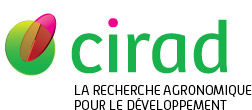Pugeaux Pauline, Depigny Sylvain, Carval Dominique, Fansi Gabriel, Tixier Philippe. 2024. Effects of 12 crops associated with plantain on arthropods trophic groups and Cosmopolites sordidus abundance. Journal of Applied Entomology, 148 (7) : 793-803.
|
Version Online first
- Anglais
Sous licence  . .
J Applied Entomology - 2024 - Pugeaux - Effects of 12 crops associated with plantain on arthropods trophic groups and.pdf Télécharger (1MB) | Prévisualisation |
|
|
Version publiée
- Anglais
Sous licence  . .
609705.pdf Télécharger (1MB) | Prévisualisation |
Url - jeu de données - Dataverse Cirad : https://doi.org/10.18167/DVN1/VFV9O5
Résumé : The control of pests and diseases is one of the main challenges of sustainable agriculture. Plantains, with an annual production of nearly 12 million tons, are a significant staple food crop in West and Central Africa, as well as in Central America. Cosmopolites sordidus is the major pests for plantains and is present in all production areas. This study assessed how the traits and associated agricultural practices of 12 crops, usually associated with plantains in Cameroun, affected the arthropods trophic network and C. sordidus abundance. The abundance and the diversity of arthropods in experimental plots associating plantains with each of the 12 tested crops were measured. Each associated crop was described by a unique profile of traits and agricultural practices. This 'trait' approach allowed linking the plant characteristics to the abundance of arthropods from different trophic groups. Structural equation modelling was used to analyse the interactions between associated crops traits, their associated agricultural practices and the abundance of main trophic groups. The highest abundance of C. sordidus was observed in plots with Ananas comosus and Xanthosoma sagittifolium as associated crops. These plots also had the lowest abundance of omnivores and predators. In contrast, plots with the lowest abundance of C. sordidus were those with weeds and Vigna unguiculata, where more omnivores and predators were observed. Grouping associated crops by their traits and agricultural practices allowed for drawing conclusions on a wider range than the set of plants tested. For instance, this study showed that plants from the higher strata tend to decrease ground-dwelling predators. The ideal crop traits and agricultural practices to maximize the regulation of C. sordidus should not be obtained by a single species of crop but rather by a community of associated crops.
Mots-clés Agrovoc : Cosmopolites sordidus, Xanthosoma sagittifolium, Musa, Ananas comosus, Musa (plantains), agroécologie, Arthropoda, agroécosystème, pratique agricole, agriculture durable, contrôle de maladies, ravageur des plantes, lutte antiravageur
Mots-clés géographiques Agrovoc : Cameroun
Mots-clés libres : Agroecology, Arthropod food webs, Cameroon, Multitrophic interactions, Musa spp., Pest control, Plantain
Classification Agris : H10 - Ravageurs des plantes
F08 - Systèmes et modes de culture
Champ stratégique Cirad : CTS 4 (2019-) - Santé des plantes, des animaux et des écosystèmes
Agences de financement hors UE : Agence Française de Développement
Projets sur financement : (FRA) Amélioration durable de la productivité et de la compétitivité de la filière plantain au Cameroun par l'utilisation de technologies innovantes
Auteurs et affiliations
- Pugeaux Pauline, CIRAD-PERSYST-UPR GECO (CIV) - auteur correspondant
-
Depigny Sylvain, CIRAD-PERSYST-UPR GECO (FRA)
 ORCID: 0000-0003-2207-9904
ORCID: 0000-0003-2207-9904
-
Carval Dominique, CIRAD-PERSYST-UPR GECO (REU)
 ORCID: 0000-0002-1525-2855
ORCID: 0000-0002-1525-2855
- Fansi Gabriel, CARBAP (CMR)
-
Tixier Philippe, CIRAD-PERSYST-UPR GECO (LAO)
 ORCID: 0000-0001-5147-9777
ORCID: 0000-0001-5147-9777
Source : Cirad-Agritrop (https://agritrop.cirad.fr/609705/)
[ Page générée et mise en cache le 2025-03-01 ]




